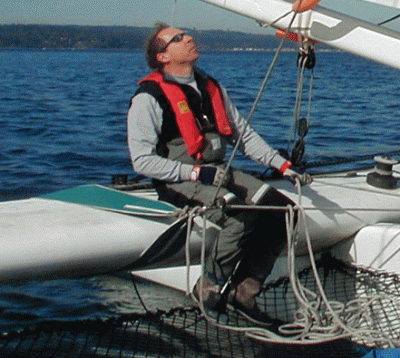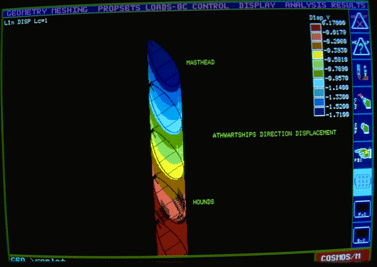It seems that I will be working in Uganda on the 65′ ferry project starting next Monday the 23rd until June 2nd. I will have the laptop with me and will work there. I’m guessing there will not be any web access.
See also http://www.earthwiseventures.com/The_Ferry_Project.html
the Diaper
I don’t know how it got the name “the diaper” but it did. The diaper supports the turning blocks for the genoa, screecher or spinnaker, without a track. It works on both a composite beam or a tube beam. It’s a soft solution, like removing the cars and tracks from the boom. I’m sure others have done them, but I have never seen another one. They disperse the load over a large area of the composite beam. They are infinitely adjustable sideways. They require no holes to be drilled into the beam. A sailmaker made mine.

Latest USCG
I believe that government can be force for good, but USCG are really yanking my charter boat operators around. And I’m spending my week doing jobs that I should not have to bother with. I thought it would be a simple substitution of 185 lbs for 160 lbs with everything else kept the same. They are coming up with new hurdles that were never in original stability requirements. Everyone agrees that the new heavier passenger weight makes catamarans more stable. So why does trivia like not counting the number of soda cans aboard become grounds for losing your stability letter? Did they get a big funding increase there with orders to be difficult? I sound like a cranky old teapartier now.
Air-Building Boatsheds
I remember when Mark Evans worked on his Sally Lightfoot trimaran in one of these air buildings. Even on summer days it was bearable, to my surprise. It was high inside. I found these guys online http://www.websweeper.com/php/pool_domes/do-001.php
I’m impressed at the low cost.
I always wanted to do a portable house like this anyway. http://blog.modernmechanix.com/2008/05/21/your-own-inflatable-dome-make-it-from-a-kit/?Qwd=./PopularScience/7-1973/inflatable_dome&Qif=inflatable_dome_0.jpg&Qiv=thumbs&Qis=XL#qdig
I wish they were still available. I see it has plans, sort of… like I need another project.
Spam
I do try to respond to all the comments. I’ve noticed that the spam catcher gets about 350 spam a week. And it tells me that there have been over 10,000 overall. I have not been looking in the spam bin. I did once and found Orval’s note. Not sure if its real or not. If you sent a note and got no reply, hit me at khughes@multihulldesigns.com.
FEA of a Wingmast
Over the weekend I caught up with Paul Steinert, my co-presenter of a paper we did for the 1994 (that damn long ago?) MACM composites conference. The paper was a finite element study of a wingmast, designed with no shear web in it. I had a hunch that if you took the material that was the typical shear web and put it on the walls of the wing mast, you could increase strength and stiffness while decreasing weight. To acomplish shear transfer, there would be bulkheads placed at certain locations in the mast. I built and tested models, with good results, but I wanted an FEA study to confirm and Paul did it. The nested curved plate equations exploded in later versions of Word so I did not push it ahead. And some of the screen shots are gone forever. It was done for plywood, but results are just as valid for composite. I will repair the file and publish soon.

First Updated Stability Letter
I just got word of the first of the updated Stability Letters for the new passenger weight for COI cats. It took the Coast Guard 3 months turnaround time. And the CG is indeed using it as a dragnet to scoop up anyone who missed any step years ago. Some people are now learning what a deadweight survey is. Don’t wait until December.
And in San Diego area
Also, Aolani came to my attention as I’m doing the USCG update. It’s one of the 58 Sunchasers. Its certified for 49 passengers. See http://www.aolani.cc/ and they have a trick little 360 degree camera at http://www.aolani.cc/360_inside.html
Catamaran Sailing in the Ozarks
Who knew? A KHSD 48 carrying passengers in Branson, MO. See http://www.stateparkmarina.com/spirit.php
Wind Load
Here is a simple little wind load calculator that I seem to use all the time for things. http://www.sailingusa.info/cal_wind_load.htm